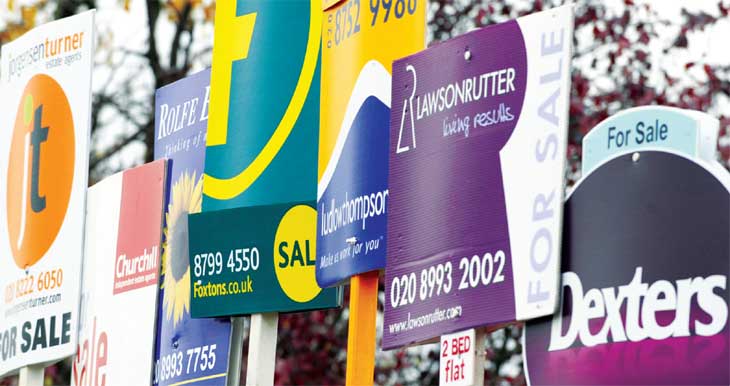Show me a sign
Andrea Kirkby inspects the serried ranks of For Sale and To Let boards that line the streets – where permitted.
Andy March, Director at Signboard, says, “There have been restrictions in Westminster for ever, but it’s been spreading – though throughout the country it’s still in only a minority of areas.” He points out that there’s no government directive; the move to ban or limit signage is purely driven by local residents and local councils. (The only national regulation that applies is the maximum half metre surface area.) But, he says, it’s clear to see why councils like these bans, “It’s an easy thing to do, it makes local residents happy, and it doesn’t cost them anything!”
Ban the board!
Boards are not getting banned everywhere.
In Westminster, there’s a blanket ban, but other councils have been selective. For instance, in Brighton & Hove, boards are effectively banned (unless planning permission is applied for) in a number of conservation areas, while in Nottingham and Reading, areas with a high number of student lets have seen the councils take action.
Agents in signboard ban areas are keen to find a way around it, so you can tell that their absence makes a dent in their business. Tom Cummuskey, Kremer Signs.
 Tom Cummuskey, at Kremer Signs, says bans are most common in upmarket areas where “boards are not always welcomed by residents.” However, he says, agents wanting to find a way around the ban can often still use window boards. (He’s quite proud of the window boards Kremer makes, which have been designed to allow light into the room while still presenting a clear message to the outside world.) And, he says, the restrictions are usually binary, “You can either have a board up, or you can’t,” rather than introducing extra regulations on what’s allowed on the board, or local size limits.
Tom Cummuskey, at Kremer Signs, says bans are most common in upmarket areas where “boards are not always welcomed by residents.” However, he says, agents wanting to find a way around the ban can often still use window boards. (He’s quite proud of the window boards Kremer makes, which have been designed to allow light into the room while still presenting a clear message to the outside world.) And, he says, the restrictions are usually binary, “You can either have a board up, or you can’t,” rather than introducing extra regulations on what’s allowed on the board, or local size limits.
So do we still need signboards, or are they on their way out? After all, we’re told that 80 per cent of property searches begin online. Does the signboard have a future in a digital age? Andy March says agents who order boards from him don’t think the For Sale board is outmoded. “95 per cent of them feel a board is an essential part of marketing.” He explains that boards reach viewers the portals don’t; a board will be seen by passers-by who are not actively searching for property, but could be tempted if they see a board up on a property they fancy. And, he says, “People relocating will still go and walk or drive down the street, to get a touchy feely idea of the area they’re moving to.”
That’s borne out by Tom Commuskey. He says agents in areas with a signboard ban are always keen to find a way round the ban, “so you can tell that the absence of boards must make a dent in their business, or they wouldn’t be trying to come up with new ideas for them. They’re still keen to have a street presence.” That helps to sell individual properties, but equally, helps promote the agent’s brand and increases general public awareness.
Time and place
 Of course you’d expect board manufacturers to say the board is vital. But David Salvi, despite being one of a select few agents who has come out publicly in favour of a board ban, still says the board is a vital sales tool. “For Sale boards are one of the best sources of enquiries for a property company,” he admits. “They do work, they’ve always worked, and they’re still working.”
Of course you’d expect board manufacturers to say the board is vital. But David Salvi, despite being one of a select few agents who has come out publicly in favour of a board ban, still says the board is a vital sales tool. “For Sale boards are one of the best sources of enquiries for a property company,” he admits. “They do work, they’ve always worked, and they’re still working.”
For Sale boards do work, they’ve always worked and they still work, but you don’t want to see loads of boards all the way down the street. David Salvi, Hurford Salvi Carr.
However, he says, they’re not particularly useful to a central London agent. Many of the properties handled by Hurford Salvi Carr are apartments, located in blocks where the managing agent doesn’t allow boards. (Indeed, a plethora of boards on a block of flats may indicate that block management is not up to the mark – not the impression that agents want to give.) A move towards more discreet marketing, particularly at the top of the market in central London, may also mean that many sellers prefer to eschew the traditional board. “Some buyers,” Salvi says, “prefer not to have boards or to put their properties on the portals, but ask the agent to introduce buyers discreetly and without publicity.”
In fact, he says, even though boards do work for his agency, he’d love to see them banned across London. “You don’t want to see a load of boards all the way down the street,” he says. “They’re ugly. And often, they’re attached to battens nailed into the mortar, and damage the property.”
New boards please!
However, the traditional board is still going strong, despite digital competition. Some attempts have been made to build digital technology into the boards, such as QR codes, which Tom Cummuskey says are being used by about 10 per cent of agents “to get images of the property out to the viewer in a user-friendly way.” He also thinks more agents will pick up NFC (Near Field Communication) technology, which uses a tag that can be read by a smartphones and touchpads when placed near it. “Those can let the user shortcut straight to the details for the individual property, bypassing the agent’s front page,” he says. And the cost of the NFC tag? About 90p. Not bad for a device that can dramatically improve response rates.
However, neither QR codes nor NFC have really taken off. Indeed Andy says “QR codes are old news – and have been for a while.” Of the larger agents, he says, Knight Frank, Savills, and Reeds Rains never bothered with codes, “only Winkworth springs to mind” as a big user. One reason is the fact that QR codes clash with the rest of the design, and spoil the visual effect of the board. The problem with NFC, adopted by Strutt & Parker, was that in 2011, only one or two smartphones had the ability to read the tags. Now, though most phones can do so, interest in the technology waned. David Salvi says Hurford Salvi Carr didn’t adopt either NFC or QR codes, and he doesn’t see them widely used by other agents, either. “All these technologies sounded good but didn’t really work – whereas the property portals and agents’ own websites do work,” he says. Besides, he says, most portals now offer map search, which allows viewers to narrow their search down to a streets. He wonders whether in fifty years’ time “the signboard icon will exist on the maps, but not the real thing!”
Designer boards
So perhaps the signboard is best left in its pre-digital form. The biggest changes happening in the signboard world are analogue ones, such as reflective boards, which Tom Commuskey says are becoming more popular, enabling the board to remain visible at night. Andy March is sceptical, “Who goes househunting in the dark?”
The “gallows” or “hangman” board is finally becoming more popular, despite its gruesome name and high price. Andy says it’s three times the cost of the average board, because of the cost of timber and machining, and it will only work if the property has a good frontage and garden – but it’s become a key choice for prestige properties. He also sees a number of agents using different shapes of board, notably EweMove which uses a sheep – a complex punched shape, but still delivering high visibility at a relatively low cost.
Designs are changing, too. “The more simplicity, the better,” Tom Commuskey says. “The days of lots of colour tones and four colour images, are disappearing; it’s solid colours now, often with only two or three colours, and a lot of people are people are using white boards, because brightness is always eye-catching.”
Board management
Agents also need to manage their boards better – not least because councils are getting increasingly stroppy with agents who leave them up more than two weeks after a property has been sold or let. That’s why more agents are outsourcing to management firms like Agency Express and Countrywide Signs. Stephen Watson, Managing Director at Agency Express says, “As demands on estate agents continue to increase, remembering to retrieve a board or to request a service can be missed so we have spent over a decade fine tuning SignMaster3, the most effective way to manage estate agency boards on a daily basis. This board management system is crucial; it provides agents with a wide array of functions giving them total control and visibility of their agency board work. We can also alert them when a board has been in situ for three months, the agent can then evaluate board and request the appropriate service; this safeguards the agent and reduces board loss through non retrievals.
David Salvi thinks the board’s days are numbered. “Traditional estate agency has embraced and mastered online marketing,” he says, “and can live without street signs.”
But Tom Cummuskey says business is still doing well – he confidently expects another record year, and a bright future for his company’s product. “It’s the oldest marketing tool available to an agent, and I think still the strongest,” he says. “Everyone can see a board, whether they’re connected or not, and it increases awareness of your brand to an unrestricted audience, whether they’re looking for a property at the moment or not.” Our streets look likely to be decorated with estate agents’ logos for some time yet.





